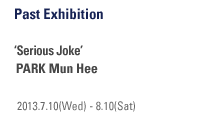
- GALLERY
- CURRENT
- UPCOMING
- PAST
- Half side/Other side
- EIN STEIN Thinking about Thinking
- Fiminism Fnositicism
- Portrait the Nature:Stars and Flowers
- white-hole diary
- ART369
- ABSINTHE1
- Completion in Incompletion
- Full of Emptiness
- Luminizing Sequence 2: Into the Maze of Momentum
- Characterless Characters
- Architecture of Illusion
- Whispering of Layers
- Small is Beautiful
- Urban Park
- Construction & De-Construction
- Serious Joke
- Retrospective
- 위대한 설계
- Fearless Creation
- Some Watchtower
- Fantasy Factor
- 적극가담자-방관자
- Root of Imagination
- SIGMA COMPLEX
- K's Room
- SUM IN A POINT OF TIME
- Memories
- Ordinary People
- Root of Imagination
- 幻 Solid Illusion
- 화해: Reconciled
- ARTISTS
- CHA Seung Ean
- CHANG Cheol Won
- CHOI Won Jung
- CHOI Wool Ga
- HAN Jin Su
- HAN Won Suk
- HONG Buhm
- HONG Zi
- KIM Ha Young
- KIM Ji Eun
- KIM Ki Ra
- KIM Si Nae
- KIM Young Bae
- LEEFI
- LEE Seung Min
- LEE Su Jin
- LEE Yeon Sook
- LEE Yong Baek
- PAE Sung Hee
- PARK Cheon Wook
- PARK Jung Hyuk
- PARK Mun Hee
- PARK Sang Ho
- PARK Seung Mo
- PARK Seung Yea
- PARK Sung Yeon
- RYU Jung Min
- RYU SungHun
- SEO Min Jeong
- SIM Seung Wook
- YOON Byung Woon
- NEWS
- TOMORROW+







유기적이지 않은 유기체
박문희의 작품에는 인간과 동물, 그리고 자연이 풍부하게 나타난다. 그러나 그것들은 있는 그대로의 모습으로 재현되지는 않는다. 수수께끼처럼 한 겹, 또는 여러 겹으로 에워싸여 있다. 작가는 지시대상을 포기하지 않으면서도 그것을 투명하게 드러내려 하지 않는다. 그것을 보는 순간 ‘이것이구나’ 하면서 대상을 가상적으로 소유하는 대신에, ‘이게 뭔가’하는 추리력을 발동시켜야 한다. 이러한 간접적인 방식은 그가 생명체에 대한 탐구를 주제로 한다는 것에서 온다. 여러 사물의 복합체로 구성된 것으로 보이는 미지의 생명체들은 그것이 직관적으로 이해될 수 있는 단일한 대상이 아니라, 여러 관계의 조합으로 이루어졌음을 예시한다. 그의 작품은 단일한 물질로 만들어진 작품조차, 이것저것이 동원되어 짜 맞춰 진 설치물이라는 느낌을 준다. 여러 작품에 나타나는 포장 막 같은 형태는 내부와 외부 사이의 불일치를 조성한다.
박문희의 작품은 생명체를 대상으로 하지만 생명처럼 자연스럽게 발생한 것이 아니라, 구성된 것이며 관객은 재구성을 통해 작가가 제안한 인식론적 게임에 참여한다. 여기에서 관계란, 대상(동일성) 자체를 이루고 있는 이질성(타자) 간의 관계, 주체와 대상의 관계 등을 포함한다. 박문희의 작품은 유기체를 다루지만 유기적이지 않다. 그의 작업은 선택된 대상의 부재나 변형을 암시하는 장치들의 고안에 집중된다. 그것들은 영원히 풀리지 않는 수수께끼에 탐닉하기 위한 것이기 보다는, 탐구를 시작하고 이끌어나가는 유혹의 장치라 할 수 있다. 여기에서 모순과 역설어법은 자주 사용된다. 생명체를 대상으로 한다는 점 뿐 아니라, 때로 예술품은 자율적인 생명체로 고양되기도 한다. 그의 작품에서 생명은 자명한 출발이 아니라, 도달해야 할 미지의 대상이다. 사물은 사물을 연출하는 방식만큼이나 다양하게 인식될 수 있다. 그의 작품은 생명의 기원과 목적 같은 관념론적이고 신학적인 가설, 즉 대답될 수 없는 추상적 질문이 아니라, 생명체로 인지되기 위한 현실적 조건을 제시하려 한다.
이선영(미술평론가)
The Non-organic Organism
People, animals, and nature richly populate Munhee Park’s works in an altered state; they dwell veiled manifold, like puzzles. Park refuses to neither surrender the slight clues nor transparently release their identity. Instead of recognizing the object as “being such and such,” and claiming virtual ownership immediately upon casting eyes upon the object, the viewer is encouraged to infer reasoning and ask “what could this be?” This indirect, circumnavigating detour of a method is Park’s underlying theme of enquiry into living organisms. Strange organisms that appear to be a conglomeration of several objects cannot be grasped intuitively as a singular object, but viewed as a combined illustration of multiple relationships. Even works created from a single substance gives the impression of eclecticism, and the “cover,” found on many of his works create discord between the interior and the exterior.
Although Park’s works appear to consider organisms as the object, they do not feel naturally occurring as life is, but rather contrived, beckoning the visitor to participate in an epistemic game proposed by his reconstruction. The scope of the term relationship covers the exchange between heterogenic(dissimilar) aspects that compose the object(homogenic), and also between the agent and the object. In this context, the artist’s works deal with organisms without being organic themselves. Park’s processes focus on the devices that infer an absence or transformation of the object in question. The devices are not indulgences to the unsolvable enigma, but a beckoning to exploration, where contradictions and paradoxes are commonplace. Park’s art is oriented on organisms, and sometimes even take the form of an organism with free will. In his work, life is not a self-evident place of departure, but an unknown destination to be sought. An object may be understood in ways as diverse as the means through which it can be expressed. Unanswerable abstractive questions like those revolving around the origin and purpose of life are not found in Park’s works. Suggested instead are realistic conditions necessary to be recognized as life.
LEE, Sun Young (Art Critic)
